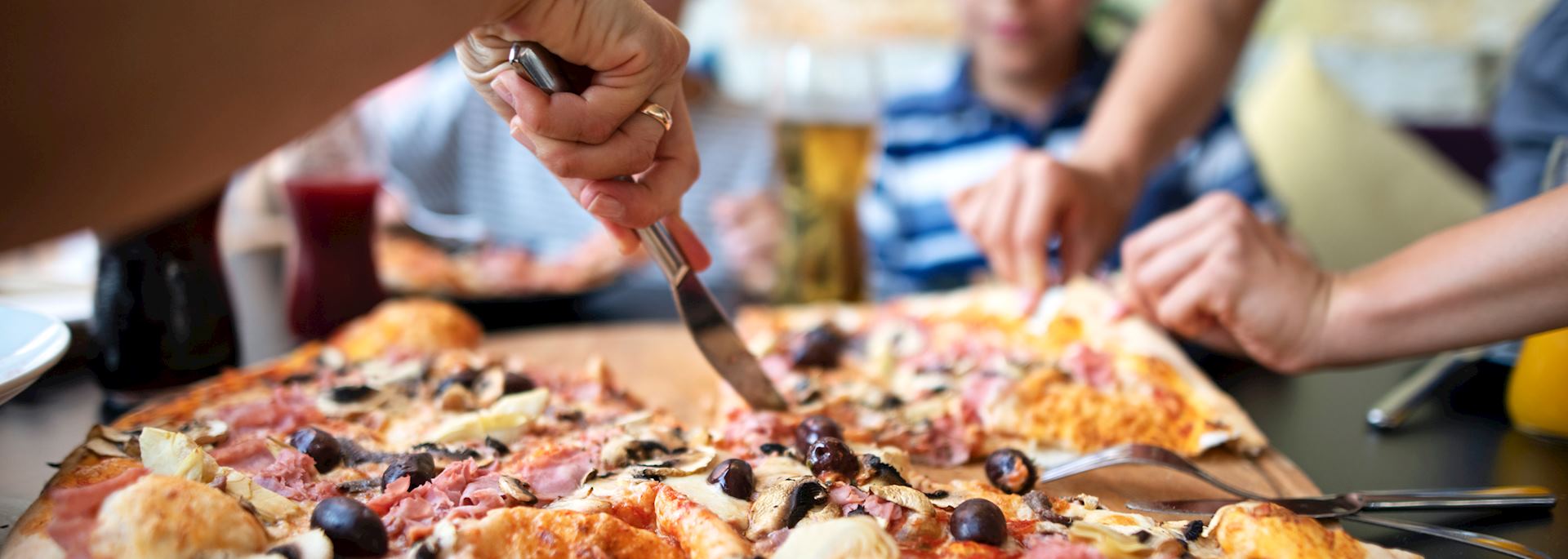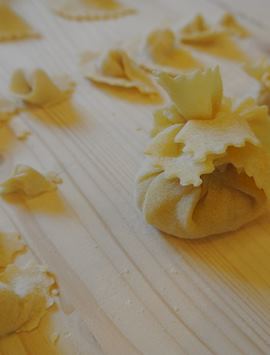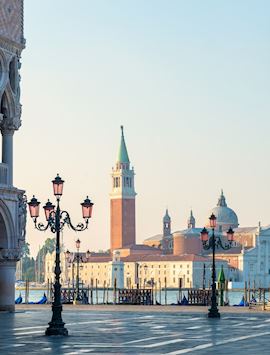By Italy specialist Laura
A family trip to Italy has much to recommend it: an efficient rail network, some of Europe’s most familiar ancient history, and a cuisine that tempts even picky eaters. Not to mention gelaterias on (nearly) every corner.
The country also abounds with interactive experiences, so I can always suggest something that will engage everyone in your family, from toddlers to grandparents. That might be a pared-back pizza-making class for an eight year old or a high-tech exploration of Pompeii for a screen-obsessed teen.
Of course, the right hotels are vital for a family trip and here, too, Italy excels. The sheer number of options across the country means you’re spoiled for choice, whether you want a family suite, adjoining rooms, or a Tuscan villa with a pool.
Rome for families

All roads lead to Rome and most trips start here, too, including our classic Italy family adventure. I suggest exploring Rome’s most renowned landmark — the Colosseum — with an expert guide. They can tweak the tour to suit your family, whether that’s finding resting places for shorter legs (or grandparents) or focusing on the gods’ role in the games for a mythology-obsessed ‘tween.
A private tour of the Vatican Museums, Sistine Chapel, and St Peter's Basilica can be similarly tailored. Your guide will steer you around any crowds and focus on the sights that will keep your children’s interest. If museums and ancient ruins are a bit tame for your high-energy children, I can arrange a lesson in gladiatorial combat. I love the hands-on, immersive nature of the class, which tutors aspiring gladiators and gladiatrices in ancient Roman-style tactics and martial arts. Children (and ambitious adults) don traditional tunics, tied with rope belts, and get a lesson using wooden swords and lightweight shields. By the end of the session, you can engage in a full-throated sword battle.
Best family-friendly stay in Rome
In the heart of the city, the Hotel de Russie has special welcome packs for children and teens, as well as a milk-and-cookies turndown service.
Tuscany for families

Even young children probably have a passing familiarity with Florence’s most renowned art, like Michelangelo’s David and Botticelli’s Birth of Venus. Getting a chance to see these masterpieces in person can be a special moment, but both the Uffizi and Accademia Galleries can be overwhelming for young visitors. Here, a private guide can help you navigate the maze-like galleries and schedule timely breaks while still ensuring that everyone sees the highlights.
Florence is also home to an exceptional cooking school, where your whole family can roll up their sleeves and get their hands dirty. You’ll learn to make classic Tuscan dishes, including pasta from scratch. After the lesson, you’ll sit down for a family lunch to enjoy everything you just made.
Outside the city, you can collectively stretch your legs on a truffle hunt through the Tuscan countryside. You’ll meet a family at their traditional farmhouse and head out onto the estate with trained dogs to forage for the elusive truffles that grow under the trees.
Even if your children aren’t interested in eating the pungent fungi, they’ll likely be charmed by the dogs (a woolly, teddy-bear-like breed).
Best family-friendly stay in Tuscany
The Hotel Santa Maria Novella is just a short walk from the city’s main sights but soundproofed enough for even light sleepers. You can opt to stay in the adjoining family rooms, which have great views onto the city.
Venice for families
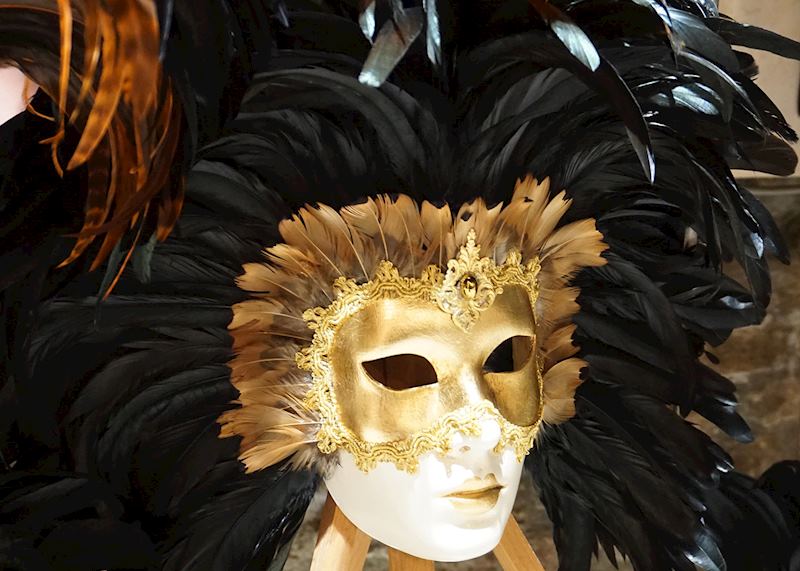
More than any other Italian city, Venice feels like you can have an adventure just wandering around. There are no cars or Vespas to keep an eye out for, and the tight-packed layout creates shade, preventing overheating. Children are likely to be entertained by the novelty of getting around by vaporetto (Venice’s public boat service) and, if that wears thin, you can head to the beaches on the Lido.
Children (and adults) who want to try their hand at making one of Venice’s signature masks can take a half-day workshop with an artisan who makes masks using traditional techniques. You’ll get to explore a shop packed with different styles and shapes of masks, from the simple columbine, which only covers the top half of the face, to the beaky excess of the medico della peste (the plague doctor). Then you’ll cross the canal to the small workshop, where you can create your own masterpieces.
Best family-friendly stay in Venice
The Belmond Hotel Cipriani has one of the only hotel pools in Venice, making it a good option for families who want to schedule in downtime.
In & around the Amalfi Coast for families


The Amalfi Coast is known for its sun-drenched glamour, glitterati visitors, and sweeping Mediterranean views. I love these things, but they have limited appeal for the schoolyard set. That doesn’t mean families need to skip the area — there’s plenty of child-friendly things to do nearby.
It’s just a short drive to Pompeii, where an expert guide can bring the hollowed-out city to life with descriptions and thoughtful answers to children’s questions. For another layer of realism, however, I suggest a 4D tour.
Your guide will then lead you through the streets, illuminating the history with vivid words. At strategic points, when words are simply insufficient, they’ll instruct you to put on a pair of futuristic goggles. Wearing them lets you see a movie-like virtual reality recreation of ancient Pompeii. Peer at a market filled with toga-clad merchants or watch the billowing black-and-red wall of superheated destruction barrel down from the crater of Vesuvius.
If that’s a bit much for a sensitive child, you could visit nearby Sorrento instead. According to local legend, pizza Margherita was invented in 1889 by a Neapolitan pizzaiolo (pizza maker) to celebrate a royal visit from Italy’s Queen Margherita of Savoy. If, like most children, your child adores pizza, you can take a cooking class in the town.
The class takes place in a boutique hotel overlooking the Bay of Naples. It begins with the children meeting the pizzaiolo before they roll up their sleeves and plunge their hands right into making their own dough. Neapolitan pizza is known for its thin crust, and the children can learn how to knead, stretch, and shape the dough to get the signature texture. Once they’ve achieved the right foundation, they’ll add sauce and a few toppings (and hear why proper Sorrento pizza doesn’t need too many), before using a peel to slide their creation into the searing heat of the brick oven — with the pizzaiolo’s help.
Cooking doesn’t take long. It’s just a few minutes before the pizza is blistered at the crust and slightly charred on the bottom, the cheese melted to gooey perfection. Then, of course, the climax of the class is the children eating their own pizza for lunch.
Best family-friendly stays in & around the Amalfi Coast
The Belmond Hotel Caruso is a treat for children whose cinematic aspirations have been stirred by the 4D glasses. The hotel offers a ‘Make your own film’ package, which invites children to work with a professional filmmaker to script and then film a scene of their own devising.
The Hilton Sorrento Palace offers interconnecting rooms, two pools, a kids’ club, playground, and babysitting service, for when the adults want to eat something besides pizza.
Puglia for families
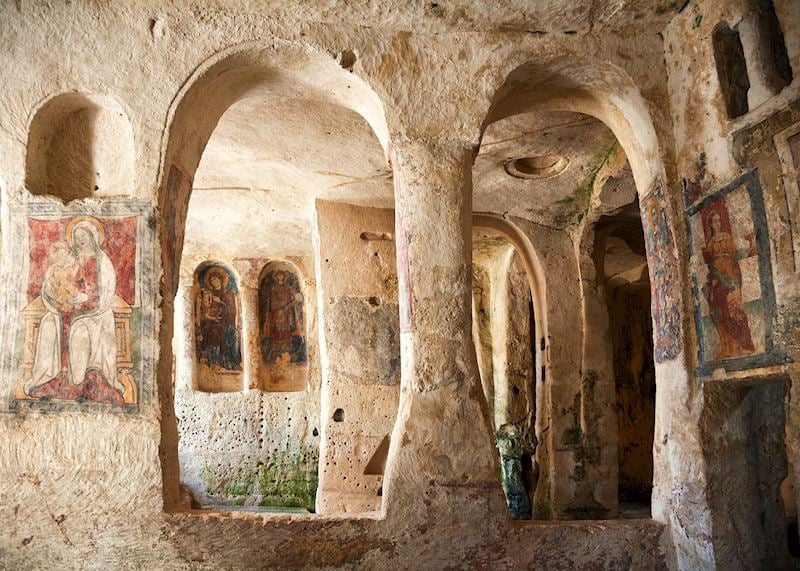
Sunny and less busy than the northern cities, Puglia is home to many of Italy’s best beaches. Down in the heel of Italy’s boot, it’s a great destination for a relaxing escape or even just a coda to a busy itinerary in the cities. That said, there’s plenty to do here besides lounging in the sun — and a visit to nearby Matera is a good place to start.
A troglodyte city built into the side of a ravine, Matera’s a great destination for families, and a private tour lets you explore the houses, hotels, shops, and cafes set inside caves. There’s something storybook about having your guide pull out an oversized key and unlock a massive door that creaks open to reveal a well-preserved church.
On a practical note, the city’s vertical layout and steep stairs make it unsuitable for little ones who need to be pushed or anyone with mobility issues. But, it’s a great option for tiring out energetic older children.
Best family-friendly stay in Puglia
If you want to take advantage of the region’s beaches, the Borgo Egnazia is a brief shuttle ride from the shoreline. It has two kids’ clubs (one for youngsters and one for teens), a children-only pool and restaurant, and small cars for helping children navigate the sprawling grounds.
Sicily for families

A world apart from the mainland, Sicily is a great choice for second- or third-time family trips to Italy. Europe’s most active volcano, Mount Etna, rises from the east side of the island, and many children would jump at the chance of visiting an active volcano.
You’ll meet your guide, a professional volcanologist, at the foot of Etna, to climb into the all-terrain 4x4 vehicle and start the drive up the steep and fertile slopes. Villages, vineyards, and pine forests gradually give way to bare black rock as you get closer to the summit.
En route, your guide will stop to examine old lava flows and craters and explain the geology of the volcano and its relationship with the island. You’ll end with a cable-car ride to the peak, where you can walk along the rim.
For families who enjoy hiking, you may want to visit Zingaro Nature Reserve on the northwest tip of the island. Here, a private guide can lead you through the unspoiled landscapes that abound with wildlife. Any budding naturalists will enjoy the chance to glimpse species like Bonelli’s eagle and Sicilian rock partridges, or the weasels and hedgehogs that make their homes in the sanctuary. Aspiring archaeologists can also visit the Uzzo Caves, where digs have uncovered evidence of human habitation as far back as the Mesolithic Age.
If you have growing gourmets, I also suggest a cooking class geared for families. Local mother Letizia will guide you around the Syracuse market to buy fresh ingredients from the blue-and-white stalls. Then, you’ll head to her home to meet her family and, together, prepare lunch.
An accomplished cook, Letizia will help you create a meal based on the local ingredients you picked earlier. She’s deft at engaging children in the kitchen, and there are toys and a garden for those who aren’t interested in the culinary arts.
Best family-friendly stay in Sicily
On the northwest coast of the island, in Palermo, the Hotel Plaza Opera is a boutique option with junior suites that can sleep a family of four.
Lake Como for families

Cradled by mountains, Lake Como is best known for the rich and famous who come to soak up the natural beauty. However, families can also take advantage of the outdoor playground. If you have children who like being active, then I suggest including a visit to Como.
The lake is at the heart of everything here, and the best way to explore is by kayak. A guided tour with locally born Michele will get your whole family out on the sparkling water, paddling around the Bellagio Peninsula and admiring the grand villas, formal gardens, and stately parks that dot the shores. You’ll hear stories of the luminaries who came to visit the region, including Winston Churchill, Franklin Roosevelt, John F. Kennedy, Clark Gable, and Al Pacino.
You can explore on land, too. If you’re with grandparents or children who tire easily, I can arrange an e-bike tour of the lakeside village of Bellagio. On your electric-assist bike, you’ll whirr through the alleys and narrow streets of the village, past neoclassical villas and out into nearby villages like Pescallo and Aureggio. There, you’ll pedal through gardens and olive groves. At the end, the whole family can pause for a well-earned picnic snack at a small cafe overlooking the lake.
Best family-friendly stays on Lake Como
A golden-age landmark, the Grand Hotel Tremezzo sits right on the water and has some of the lake’s best views as well as interconnecting rooms.
Sardinia for families

Largely uncrowded, southern Sardinia is one of the best places in Italy for families with little ones who want a tranquil getaway and plenty of beach time. I like to head to Santa Margherita di Pula for quiet stretches of pink-and-white sand. And, when you need a break from the sun and sand, I’d head north to take in the glitz of the Costa Smeralda and maybe a cheese-themed tour.
Sardinia is renowned for its many varieties of cheese, and, with a local guide, you’ll meet the artisans and animals behind them. The tour varies with the season, and even the time of day, but you might pet a flock of sheep, watch a shepherd milk a herd of goats, or step inside the barn to see part of the cheesemaking process — sampling along the way.
Best family-friendly stay in Sardinia
With a pool, beach access, and suites that can fit extra beds, Hotel Cala Caterina makes a great base for a relaxing visit.
Getting around with children in Italy
Our classic Italy family adventure takes in the art cities of Rome, Florence, and Venice. It follows a smooth path that’s the best way to explore the country, whether you’re dealing with toddlers or teens.
While you’re in the city, most sights are usually easy to reach on foot, though if you’re dealing with children who still need to be pushed, the cobbled streets can be a challenge. We can arrange private drivers, if that’s the case, or you can simply take a cab.
The cities are linked by trains, which means you can avoid long car rides or standing in line at airports. For experiences in the countryside, including truffle hunting, you’ll have a private driver and guide who’ll pick you up at your hotel.
For family travel to Italy that’s further afield — like Sicily or Puglia — your specialist will ensure that your whole family can get where you need to be. That might mean arranging a rental car or a private driver with a larger vehicle if you’re visiting with a large family.
Best school vacations to travel to Italy

From the sun-drenched pleasure of a Mediterranean summer to Christmas in Rome, Italy is a year-round destination. If you want to travel during a school vacation, you’ll need to plan far in advance to get your choice of hotels — family suites and adjoining rooms often fill up first.
If you want to visit during summer vacation, I suggest going in June, when the weather is starting to turn warm but the cities are still relatively uncrowded. July and August can be sunny, hot, and busy, so I’d avoid those months if your children are easily overwhelmed by those things. But, if that’s the only time you can visit, your specialist will plan your trip carefully so you can avoid the worst of the throngs.
February or March break can be a great time for a family trip to Italy — your money goes much further and the sights are mostly quiet. Winter weather is relatively mild, rarely dipping below freezing, though there’s a higher chance of rain. Depending on exactly when you visit, you may want to avoid Venice during its Carnival celebrations.
During April vacation, the weather is usually comfortable but variable enough that you’ll need to bring layers. If you’re visiting during Holy Week, you’ll see celebrations across the country, and many sights will be closed on Easter Sunday and Easter Monday.
With its mild winters and deeply rooted Catholic traditions, Italy is a wonderful destination for families around winter break. The main sights are usually very quiet. The whole country shuts down on Christmas Eve and Christmas Day, but the hotels put on a beautiful holiday feast.
Read more family trip ideas to Italy
Start thinking about your experience. These itineraries are simply suggestions for how you could enjoy some of the same experiences as our specialists. They're just for inspiration, because your trip will be created around your particular tastes.
View All Tours in Italy